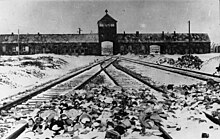The ashes of Birkenau
The Ashes of Birkenau is a poem by the writer Stephan Hermlin from his memory cycle . It was set to music as a cantata by Günter Kochan in 1965 .
poem

It was written during a visit to Auschwitz-Birkenau in 1949 and published in 1951. It is made up of five twelve-line stanzas. Hermlin deals with the Holocaust . The motifs are memory and forgetting .
The last stanza of the poem says optimistically:
"[...] No murderer will escape, no mist falls around him. Wherever he attacks man, there he is put. [...] "
The author made a warning at the same time; in a 1979 interview he said:
“I believe that this mistake of declaring the past to be overcome is very clearly committed with us. Unfortunately also from many comrades who say with a certain complacency that we have come to terms with the past, those over there not, they are still in the middle, so to speak. Nobody has the right to do that. "
music
Emergence
At the time of the ongoing Second Auschwitz Trials , the composer Günter Kochan created Die Asche von Birkenau for alto solo and orchestra (1965). He was based on the poem by Stephan Hermlin and divided his work into a total of seven movements, using the 4 stanzas as a basis and 3 composed three additional instrumental parts. The key passage is the fourth movement with his lament for the dead .
sentences
- Andante rubato
- Interlude I (Andante)
- Allegro
- Grave
- Interlude II: Moderato
- Vivace
- Epilogue: Moderato
Orchestral line-up
Soloist part (alto), 2 flutes, 1 oboe, 2 clarinets, 2 bassoons, 2 horns, 2 trumpets, 1 trombone, 1 timpani, 1 percussion, 1 celesta, 1 piano, strings
premiere
The work was premiered on May 25, 1966 by the Berlin Symphony Orchestra under Kurt Masur in Berlin. It has a duration of approx. 16 minutes.
meaning
Kochan considered the ashes of Birkenau to be one of his most important pieces. According to the company's own statements from the 1970s, the work was broadcast by more than seven radio stations. The cantata became one of the most important musical works that deal with the genocide of the Jews.
Recordings
- Annelies Burmeister (alto), Rundfunk-Sinfonieorchester Berlin , conductor: Kurt Masur (1967)
- Annelies Burmeister (alto), Rundfunk-Sinfonieorchester Berlin, conductor: Wolf-Dieter Hauschild (1975)
- Annelies Burmeister (alto), Leipzig Radio Symphony Orchestra , conductor: Herbert Kegel (1975)
reception
The Holocaust survivor Simon Wiesenthal wrote a text for the poem in 1979. In part it said:
“Now I read Stephan Hermlin's poem“ The Ashes of Birkenau ”. Birkenau came back to life and I felt the pain and sadness as if I had been in Birkenau - yesterday. "
In 2002 the last section of the poem was engraved by the sculptor Ingo Warnke in a rotating stone column near the Apellplatz in the Kaltenkirchen concentration camp memorial in Springhirsch. The text was worked into the turning stone in a spiral, so that the visitor is asked to circle the area.
literature
- Wilhelm Buschkötter, Hansjürgen Schaefer : Handbook of international concert literature. Instrumental and vocal music [Manual of international concert literature] . 2nd revised and expanded edition, de Gruyter, Berlin, New York 1996, ISBN 3-11-013905-7 , p. 479.
- Hans-Peter Müller: “The Ashes of Birkenau” for Günter Kochan's new solo cantata . In: Musik und Gesellschaft 16 (1966), pp. 553–462.
- Klaus Wagenbach (Ed.): Reading book German literature between 1945 and 1959 . Wagenbach, Berlin 1980, ISBN 3-8031-3008-5 , pp. 112-113.
Individual evidence
- ↑ Fritz J. Raddatz : What do the younger ones know about our difficult struggles? In: Die Zeit of May 14, 1995.
- ↑ Wolfgang Emmerich : Brief literary history of the GDR. Berlin 1999, pp. 318-319.
- ↑ Ursula Stürzbecher (Ed.): Composers in the GDR. 17 conversations. Hildesheim 1979, p. 195.
- ^ Heinz Ludwig Arnold : Unity and from ruins. A German anthology . Frankfurt / Main 1999, pp. 45-46.
- ↑ Information on the tour ( Memento of the original from October 7, 2007 in the Internet Archive ) Info: The archive link was inserted automatically and has not yet been checked. Please check the original and archive link according to the instructions and then remove this notice. (PDF file; 139 kB). Kaltenkirchen concentration camp memorial association in Springhirsch.
- ↑ In a playful search for the structures of reality. Observations on the sculptor Ingo Warnke (PDF file; 1.91 MB).